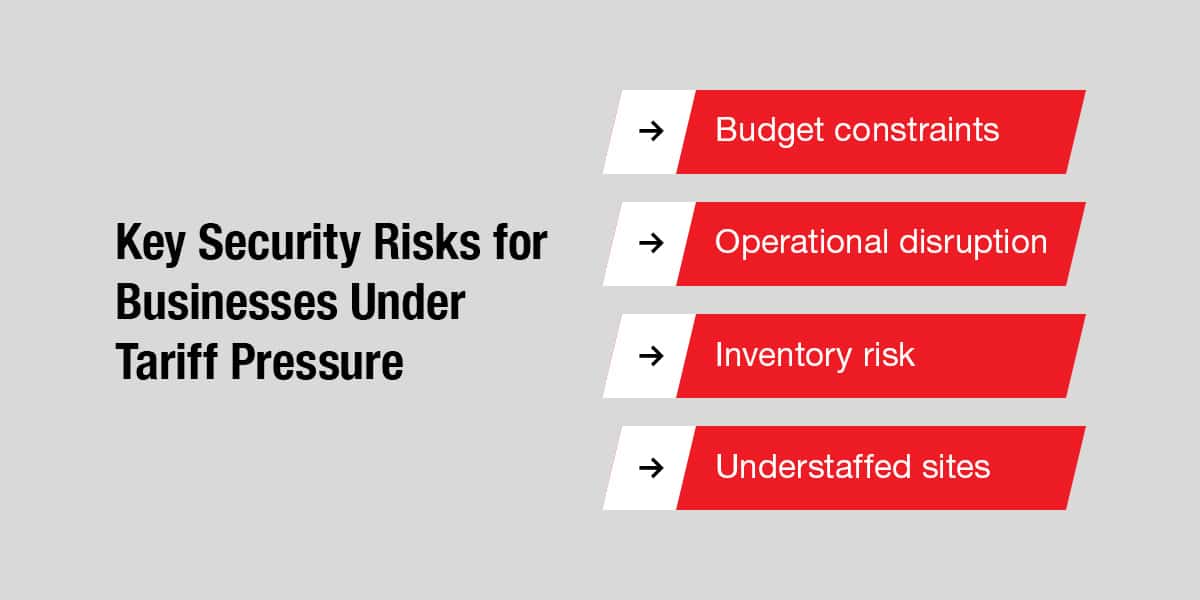In 2025, tariffs will impact the prices of commercial goods, materials, and equipment. As prices rise, so does the risk of external theft, with organized criminals becoming more enticed to target jobsites, warehouses, and trucks carrying high-value items. With fewer resources and higher replacement costs, businesses become more vulnerable. A strained supply chain increases downtime, exposing more property to theft, which shows that tariffs don’t just shift trade — they reshape the threat landscape.
In this environment, strong perimeter security is essential. By stopping threats before they reach critical assets, perimeter solutions like electric fencing, video surveillance, and access control help businesses protect their resources, employees, and reputation against theft tied to rising economic pressure.
Historical Impact of Tariffs on Theft
Historical data shows the connection between a struggling economy and crime. The Smoot-Hawley Tariff Act of 1930 raised U.S. tariffs on over 20,000 imported goods. The aim was to protect domestic industries during the Great Depression. Instead, it triggered international retaliation that slowed trade and deepened the economic downturn. Industries dependent on cross-border materials, like construction and transport, saw a significant increase in supply costs.
History shows that stolen goods like equipment, industrial supplies, and building materials are in high demand during times of economic stress. Thieves target remote or commercial properties where they are most likely to operate undetected, as they can resell stolen items quickly.
The Impact of the Economy on Crime
The state of the economy contributes to cargo theft, property damage, employee theft, and supply chain vulnerabilities. When tariffs raise the cost of imported goods, it leads to price increases across the supply chain. Consequently, higher tariffs increase property crime, especially in industrial locations. For commercial operations, especially in construction, logistics, and warehousing, this means tighter budgets and less margin for loss. As equipment, materials, and replacement parts prices increase, they become prime targets for theft.
Thieves steal from job sites, strip wiring from warehouses, or siphon fuel from truck yards. In addition to theft, businesses and government infrastructure may experience vandalism. Even before the tariff increase, telecommunications infrastructure had reported 5,700 theft and vandalism incidents in the last six months of 2024, as thieves looking for copper sometimes vandalize fiber-optic transmission lines and wireless towers that don’t use this metal.
Impact on Businesses and Potential Solutions

The economic strain that results from tariff increases affects employees and organizations alike. Workers face reduced hours or layoffs, and criminal networks exploit this instability by targeting vulnerable sites. A lack of proactive perimeter security shows thieves where they can operate with the least risk of getting caught, and businesses storing copper, which is quickly increasing in value, lumber, fuel, or heavy equipment face heightened risk.
Businesses hit by tariffs are under pressure from rising costs and shrinking profit margins. These pressures force tough decisions like cutting staff, delaying upgrades, or scaling back operations. As a result, businesses face these challenges:
- Budget constraints: As material and equipment costs rise, companies may reduce spending on security infrastructure, which includes perimeter fencing, high-definition video surveillance, and access controls.
- Operational disruption: Theft delays projects, stolen materials halt construction schedules, and interrupt supply chains. Every incident compounds financial loss and damages customer trust.
- Inventory risk: Warehouses and laydown yards hold more valuable goods to avoid tariff-driven lead times. Stockpiling increases exposure and makes these locations key targets for organized theft rings.
- Understaffed sites: Labor cuts mean fewer eyes on-site. Remote jobsites, especially in construction, become easy targets whenever they’re left unattended.
Mitigation Strategies for Businesses
Tariffs reshape the risk environment. As the value of on-site materials rises, so does the need for multi-layered perimeter security. Deterrence, detection, and response systems all form part of a proactive risk mitigation strategy that stops crime at the perimeter, before thieves reach equipment, materials, or vehicles.
Electric Fencing
An electric fence is an intimidating barrier that deters intruders before they reach your premises. The fence sends a clear message with its visible signage — unauthorized entry is not tolerated. Should anyone attempt to breach the perimeter, they will experience a safe but memorable shock. AMAROK’s Electric Guard Dog™ Fence delivers a 7,000-volt pulse every 1.3 seconds for a medically safe but highly effective physical and psychological deterrent. Electric fencing also works well with other security solutions such as remote monitoring and alarm-based lighting.
Video Surveillance
High-resolution security cameras provide monitoring capabilities in vulnerable areas and perimeter zones. While cameras alone don’t prevent crime, their footage aids in investigations, and their real-time alerts support faster response from the authorities. A setup that has the electric fence alarm direct the cameras to the location of the breach is ideal for capturing suspicious activity, so you can respond appropriately.
Alarm-Based Lighting
A well-lit exterior helps to deter criminals by eliminating their ability to operate under the cover of darkness and increasing their likelihood of being caught. Integrated lighting systems go a step further by activating when the electric fence alarm triggers. The sudden flood of bright light amplifies the deterrent effect and calls attention to the area of the potential threat.
Access Control
Controlled Gate Access Control points log who enters and exits the site. With options like badge access, gate controls, and audit trails, stakeholders can restrict access by time, role, or location to minimize risk and strengthen internal accountability. This security solution is especially useful in the trucking industry. Adding another defense layer through a building intrusion detection system can safeguard buildings by protecting any entry point with door contacts and wireless motion detection.
Choose Multi-Layered Perimeter Security from AMAROK
When tariffs increase the cost of goods, high-value items like copper, machinery, and electronics become more attractive to criminals — and theft tends to flourish. Businesses operating under tariff pressure can’t afford repeated losses. Every stolen item and act of vandalism compounds the cost. Without strong perimeter security, your business is at risk for theft, turning economic strain into long-term vulnerability.
AMAROK’s approach stops crime at the perimeter. With a combination of electric fencing, surveillance, lighting, and access control, our team assembles a security solution that aligns with your business needs. We offer security-as-a-service, so you get perimeter security at zero upfront cost with no installation costs, no maintenance fees, and no insurance overhead — just a manageable monthly fee that lets you become part of the 99% of customers who experience zero external theft after installation. Our solutions help you protect your business, employees, and brand reputation.
Contact us today for a free threat assessment. Our perimeter security experts will identify potential vulnerabilities, analyze your local crime data, and use this information to develop a proactive approach to preventing theft.




